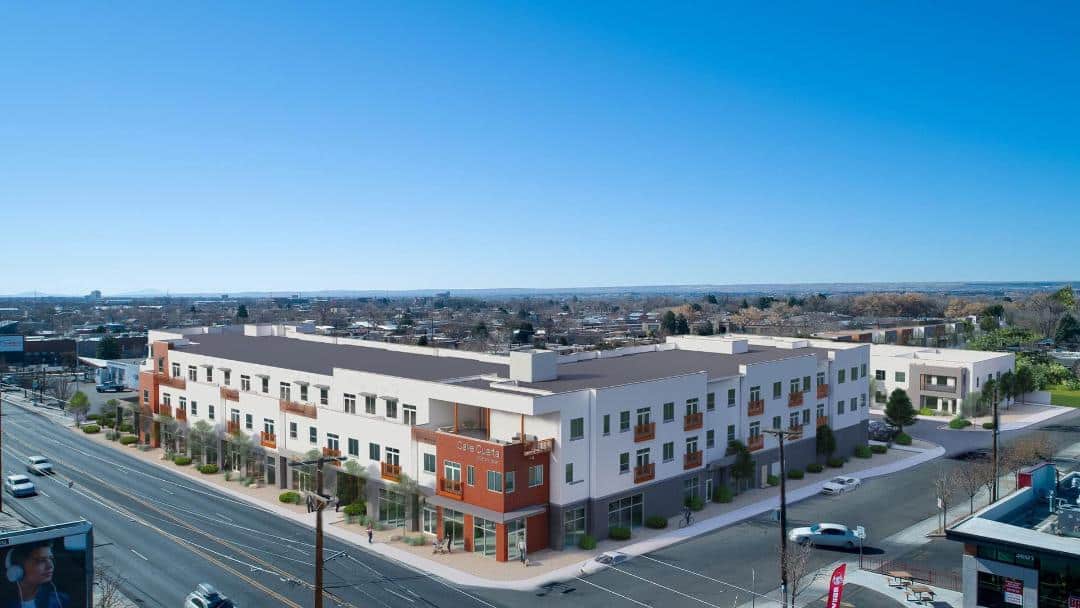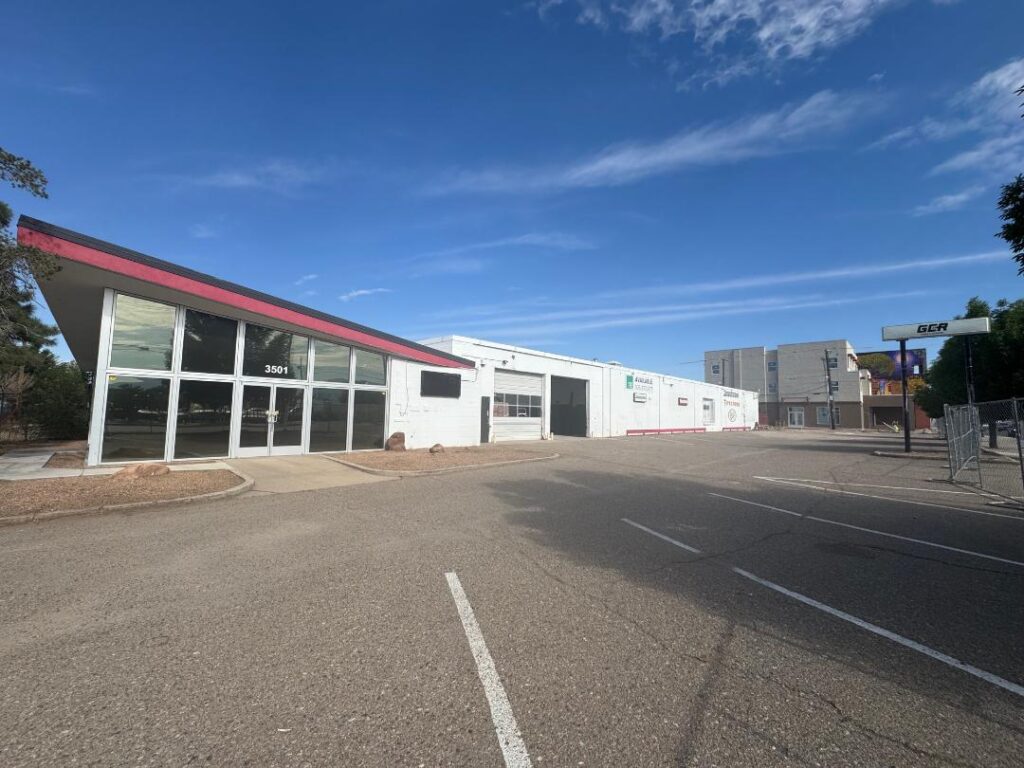A Robust Development Blooms in the Desert
In Albuquerque, YES Housing Provides Impact Beyond Affordability

By Mark Fogarty
6 min read
It isn’t very common to see market-rate single-family housing included at an affordable multifamily site. But that’s what’s planned at the Calle Cuarta development in Albuquerque, where 21 yet-to-be-built for sale homes are set to join a 61-unit affordable apartment complex completed on September 16. And that’s not all. Retail, live/work spaces and a big community center in a separate building with unusual architecture are also in the mix.
Chris Baca, chief executive of Calle Cuarta developer YES Housing, notes that the project has a larger parcel of land than usual for an affordable housing development: five acres, which increased to 7.5 acres when YES bought an adjacent Bridgestone/Firestone warehouse which it intends to make into an “intergenerational” community space. “We’re hitting several elements,” Baca says, noting that the eclectic mix “was much better for residents and much better for the neighborhood.”
This innovative design fits squarely within the 35-year old nonprofit’s mission to not only build housing, but community, Baca says. “At our core we are a community development organization.”
One component of this community-strengthening initiative is to support small businesses, which the project accomplishes by providing a renovated commercial space in the former Bridgestone/Firestone warehouse, which sits adjacent to the multifamily residential. YES originally bought the 22,000 square-foot building with plans to tear it down, but deciding against it when its brick structure was determined to be sound and its architecture an example of the unusual midcentury Googie style.
Calle Cuarta has a significant number of two and three bedroom units, creating intentional space towards housing families with children.“There’s a big need for families that can’t afford a house,” Baca says, highlighting that the project is directly across the street from a school.
Advertisement
Beyond family-friendly unit sizes, Baca notes that Calle Cuarta also features a playground, a computer center, a community study space and a social services coordinator who can arrange tutoring.
Honoring a Neighborhood Legacy
Fourth Street, where the development is located, is a corridor in Albuquerque’s Near North Valley neighborhood that is both active and historic. Once a part of the Old Santa Fe Trail, the neighborhood has its roots in agriculture, a characteristic which YES wants to sustain through gardens and a small bodega.
This won’t be the first YES project to focus on food security as an amenity for residents, and Baca points to a rooftop garden in another YES development in Albuquerque called the Imperial Building. He says the produce from the garden has contributed a significant reduction in food costs to residents. “Let’s grow food,” he says.
Calle Cuarta has a complicated capital stack, with a total of 11 different financing sources in its $35 million total development cost. Housing New Mexico (HNM), the state housing finance agency, is a key one.
Isidoro Hernandez, executive director of the agency, says HNM supported the project in four separate ways. One is the New Mexico Housing Trust Fund, which provided a $1 million dollar loan to the project in return for rent restrictions up to 80 percent Area Median Income (AMI). Second, HNM administered a $400,000 loan from the National Housing Trust Fund, which uses profits from federal agencies Fannie Mae and Freddie Mac to fund housing for those earning up to 30 percent AMI. Third, HNM coordinated a traditional loan from the HUD HOME Community Housing Development Organization program at $915,000. Finally, HNM allocated $1.4 million in nine percent Low Income Housing Tax Credits, which will generate roughly $13 million over ten years for the project.

Wells Fargo was the project’s tax credit investor. Other financing included a loan from Rocky Mountain Community Reinvestment Corporation and money from city, county and state sources.
Total HNM support for Calle Cuarta came to more than $15 million, and Hernandez says the project was “fairly cost efficient” based on that outlay.
“There is definitely a need for affordable housing in that neighborhood,” Hernandez says. He assessed Calle Cuarta’s economic impact by noting that HNM currently has 56 different developments under construction in New Mexico, totaling 5200 units, with an estimated economic impact of $1.3 billion and 17,000 jobs created. Extrapolating for Calle Cuarta would come up with a $15.2 million economic impact.
Comprehensive Offerings
The project’s 61 multifamily units break out into eight studios, 26 one-bedroom, 19 two-bedroom and eight three-bedroom apartments. Income restrictions for the units range from 30 to 80 percent of Area Median Income.
The units will be spread across three buildings, one of which will also house retail and property management on the ground floor. Another building will include space intended for live/work activity, meant to accommodate the growing number of residents who may work remotely.

Although the live/work spaces are still vacant, YES says that they have already closed on two leases for the retail shops. One, a wedding shop, is called Bougie Bridal on a Budget, and the other is an 1800 square-foot bodega.
Most of the multifamily units are leased up.
The design of the buildings mesh with the surrounding neighborhood. The commercial warehouse retains its original Googie character, while the multifamily fits with the traditional New Mexican vernacular architecture. “It is very much in tune with the Pueblo style,” says Baca. “It’s not adobe, but it looks that way.”
The yet-to-be-built single-family units will be in a townhome style, Baca says. “The space lends itself to that. Fourth Street is a residential neighborhood.” Upon completion, the townhomes will be offered for sale at market rates.
In all, “We’re very fortunate,” to have been able to pull the project off, says Baca. “We learned a lot. For every challenge, we found a way to overcome it.”
What is Googie Architecture?
The 22,000 square-foot warehouse YES Housing bought to convert to an intergenerational community and retail space at the Calle Cuarta site is contains elements of Googie architecture.
The style dates to the middle of the twentieth century. According to Matt Novak, writing in Smithsonian Magazine:
Googie is a modern (ultramodern, even) architectural style that helps us understand post-WWII American futurism — an era thought of as a “golden age” of futurist design.
It’s a style built on exaggeration; on dramatic angles; on plastic and steel and neon and wide-eyed technological optimism. It draws inspiration from Space Age ideals and rocketship dreams.
We find Googie at the 1964 New York World’s Fair, the Space Needle in Seattle, the mid-century design of Disney’s Tomorrowland and in countless coffee shops and motels across the U.S.